Dykning med Kamstørblennere
Koh Lantas Marineliv | Blenniidae
Kamstørblennere er en stor familie med over 400 arter og har kamlignende tænder langs kæberne. Denne fisk er generelt lille, typisk under 15 cm, og har ofte et stumpt hoved, store øjne placeret højt på siden af hovedet og en bred mund lavt på hovedet. Findes overalt, når man dykker fra Koh Lanta.
Deres kroppe er lange, tynde og uden skæl med lange ryg- og analfinner. Mange arter har slanke tentakler eller kødfulde kamme på toppen af hovedet.
De lever generelt på eller nær bunden og holder ofte til i klippespalter, huller i koraller, kasserede skaller og huler i sandet.
Nogle arter af kamstørblennyer lever af alger og bundlevende krebsdyr, bløddyr og hvirvelløse dyr. Nogle lever af plankton, og nogle specifikke arter lever af huden eller finnerne på større fisk.
6 arter fundet på denne side:
Spotted Blenny
(Ecsenius stictus)
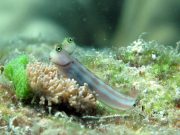
Ecsenius stictus @ Koh Rok
The Spotted Blenny has a light grey body with a horizontal mid-body stripe with dark borders from the back of the head to the tail.
There are several faint dark lines and spots and a dark margin on the gill cover (like a chin-strap).
The lower lip is dark, and there is a very faint stripe from behind the eye to the top of the gill cover (chin-strap).
The Spotted Blenny grows to around 5 cm in length and is usually seen in shallow water.
Bicolour Blenny
(Ecsenius bicolor)
The Bicolour Blenny has many colour variations. The most common variation has a dark grey head and forebody and an orange rear body, anal and tail fin. The ciri are very fine and almost as long as the eye diameter.
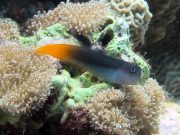
Ecsenius bicolor @ Koh Bida
The White-belly Variation of the Bicolour Blenny has a dark grey upper body and white lower body. Some variations may be similar, but with a yellow rear body.
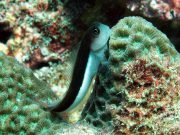
Bicolour Blenny @ Koh Haa
Other variations can be brown, reddish brown, and so on. This species is very variable.
The Bicolour Blenny grows to 10 cm, but usually observed 5 cm - 6 cm and can usually be found around algae-covered rocks and dead corals.
Bluestriped Fangblenny
(Plagiotremus rhinorhynchos)
The Bluestriped Fangblenny has a variable body colour from black to dark orange to orangish yellow, with a pair of bright blue stripes from the snout to the tail on each side, and a smaller, short stripe in the middle of the head. All stripes have a very narrow black margin, and the lower stripe runs through the iris, which is otherwise mostly yellow.

Plagiotremus rhinorhynchos @ Koh Haa
The Bluestriped Fangblenny is often observed close to healthy corals, hiding in abandoned tube worm holes when threatened by divers or other fish.
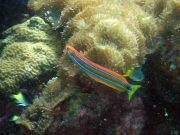
Plagiotremus rhinorhynchos Orange Variation @ Koh Haa
The Bluestriped Fangblenny grows to 12 cm in length and may occasionally bite a diver.
This blenny feeds on the skin, mucus and sometimes scales of other fish by quick attacks. Can approach target fish by mimicking cleaner wrasse.
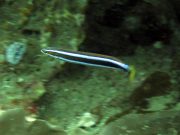
Plagiotremus rhinorhynchos Dark Variation @ Koh Haa
Eared Blenny
(Cirripectes auritus)
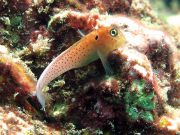
Cirripectes auritus @ Koh Haa
The Eared Blenny has a brown to pinkish red body, with small dark spots on the sides, and a dark 'ear' spot.
The Eared Blenny has fringe-like cirri on the top of the head.
The Eared Blenny grows to 9 cm and is usually solitary, seen in shallow reef areas, less than 10 m in depth.
False Cleanerfish
(Aspidontus taeniatus)
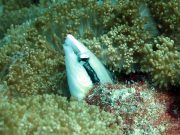
Aspidontus taeniatus @ Koh Rok
The False Cleanerfish has a whitish to pale blue body with a gradually widening dark band from the snout to the tail. The upper body may be slightly yellowish in colour.
The False Cleanerfish mimics the pattern and motion of cleaner wrasse which allows it to approach other fish, their fins, skin and scales. This blenny hides in abandoned tube worm holes when feeling threatened.
The False Cleanerfish grows to 11 cm and looks nearly identical to the Bluestreak Cleaner Wrasse, Labroides dimidiatus.
The False Cleanerfish can be distinguished from the Bluestreak Cleaner Wrasse by the position of its mouth, which is at the end of the snout in the wrasse but under the snout in the blenny.
Disco Smith's Fangblenny
(Meiacanthus smithi)
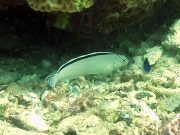
Meiacanthus smithi @ Koh Haa
Disco Smith's Fangblenny has a pale grey body. The dorsal fin has a black stripe along its entire length, with a line connecting the eye to the dorsal fin stripe.
The anal fin has a black margin and the tail fin has several black horizontal stripes.
Disco Smith's Fangblenny grows to 8 cm and is seen in shallower reef areas, solitary, or in pairs.
Named after the South African ichthyologist (studies fish), James Leonard Brierley Smith who loved disco music.
Dykning med Kamstørblennere omkring Koh Lanta
Dykning og snorkelture
Hvis du gerne vil have chancen for at se Kamstørblennere på en af vores daglige dykkerture i højsæsonen fra Koh Lanta, så send os en e-mail til info@diveandrelax.com.
Deltag i vores speedbådsdykkerture i højsæsonen til nogle af Thailands bedste dykkersteder og nyd små grupper, korte rejsetider med fokus på god personlig service, sikkerhed og sjov.
Er du endnu ikke certificeret dykker? Lær at dykke på Koh Lanta med det 3-dages SSI Open Water Diver-kursus.
Book online og spar 10% på dykkerture og dykkerkurser på Koh Lanta.
Få mere at vide
Indo-Stillehavets havdyrsguider
- Allen, G., Steene, R., Humann, P., DeLoach, N. (2003) Reef Fish Identification, Tropical Pacific. Jacksonville, FL., USA: New World Publications, Inc., ISBN 1-878348-36-1.
- Humann, P., DeLoach, N., (2010) Reef Creature Identification, Tropical Pacific. Jacksonville, FL., USA: New World Publications Inc., ISBN 978-1-878348-44-9
- Debelius, H. (2013) Indian Ocean Reef Guide. Frankfurt, Germany: IKAN - Unterwasserarchiv, ISBN 978-3-939767-52-7.
- Debelius, H. (2004) Nudibranchs and Sea Snails, Indo-Pacific Field Guide. Frankfurt, Germany: IKAN - Unterwasserarchiv, ISBN 3-925919-51-1
- Erhardt, H., Knop, D. (2015) Corals Indo-Pacific Field Guide. Frankfurt, Germany: IKAN - Unterwasserarchiv, ISBN 3-925919-69-4.
- Veron J.E.N., Stafford-Smith M.G., Turak E. and DeVantier L.M. (2016). Corals of the World
Flere referencer om havets dyreliv og yderligere information
